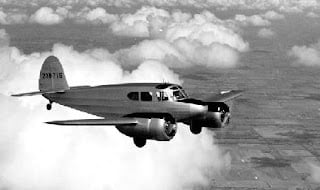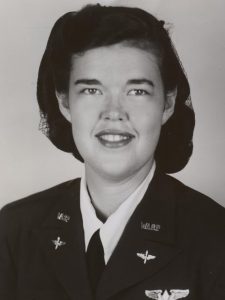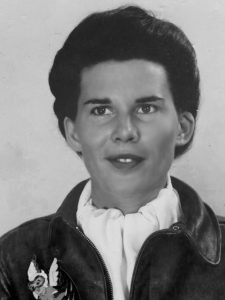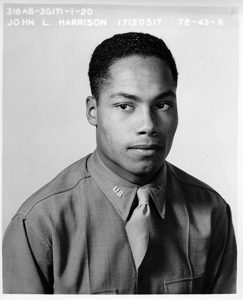 Mary Louise Webster
Mary Louise Webster
June 30, 1919 – December 9, 1944
Class: 44-W-8
Entered Army Air Force flight training: Avenger Field, Sweetwater, Texas, March, 1944
Graduated: October 16, 1944
Assignment: Administrative pilot, Engineering test pilot
Assigned bases: Frederick Army Air Field, Frederick, Oklahoma
Planes flown: PT-17, BT-13, AT-6, B-24, UC-78
Born June 30, 1919, Mary was the seventh of eight children and the second daughter.
Mary graduated from the Holy Names Academy, a private Catholic all-girls high school in Seattle. After graduation, she studied for two years at the Seattle Business College and earned her diploma. Although believing business was her best career choice, Mary had always dreamed of flying, and when Central Washington State College announced a Civilian Pilot Training course in May 1940, Mary leaped at the chance. It wasn’t easy being one of only three women accepted in the program. “I knew Mary and I liked her,” a fellow student later told a reporter. “But there was a reluctant acceptance about her being in the program with the men. There were jokes that she should be home raising kids.”
After graduation from Avenger on October 18, 1944, and following her 10-day furlough, Mary reported to Frederick Army Airbase to begin her advanced training. Mary

“Bamboo Bomber”- At-17
and a two-man crew, 21-year-old Lieutenant George Crowe at the controls and 22-year-old Sergeant Melvin Clark, were flying into a cold front with intermittent snow and rain and temperatures dropping. Their UC-78 Bobcat, nicknamed “the bamboo bomber,” was taking them on a cross-country training flight to Chicago from Frederick Army Airfield in southwestern Oklahoma. Following her graduation that October, Mary had reported to Frederick for advanced training in B-24 Liberator bombers. With only 11 days remaining until WASP deactivation, it should have seemed ridiculous to continue training; yet, there she was, flying between Tulsa and Claremore, Oklahoma.
An hour out from Frederick on December 9, the UC-78 was flying at 9,000 feet above the clouds, when Crowe noticed ice forming on the wings. He radioed the air controller and received permission to descend; hoping warmer air would keep more ice from forming. Now, deep in the clouds, the aircraft began to fall and Crowe lost control. The UC-78 fell straight down and crashed, killing everyone aboard.
Webster was one of three siblings serving in the war. Her brother Joe was flying transport aircraft in Europe while another brother, William, was a Navy lieutenant serving in the Pacific.
On Dec. 10, 1944, a Western Union employee came to the Webster home in Ellensburg with a telegram. Holderman’s mother received the telegram but waited for her father to come home to open it.
At the time, telegrams were harbingers of bad news, usually of a loved one who had either been killed in combat or was missing in action.
“They called it a black telegram,” niece Kelly Spence Holderman said. “You knew when it came, it was something bad.”
Holderman said the family initially feared it was about Joseph or William, who were in combat zones.
Instead, it was from the commanding officer at Frederick, informing the family that Webster had died in a plane crash the day before near Claremore, Okla. She was 26, and 11 days away from being discharged with the rest of the WASP when the program was to be disbanded.
Mary and two soldiers, Lt. George W. Crowe and Sgt. Melvin Clark, had received orders to go to Tulsa. They were flying in a Cessna UC-78 Bobcat, a twin-engine training aircraft also used for light transport. An investigation determined that the plane’s wings iced up, causing it to crash.
Webster would be the 38th and last WASP to die in the line of duty. Four other Washington women died while serving as WASP.
Her family also received a telegram from Jacqueline Cochran, the Air Corps’ director of female pilots, expressing her condolences.
“I hope this will convey to you how deeply we all feel about Mary’s accident,” Cochran wrote. “May God give you the strength to find comfort in the fact that when she was called upon to make the supreme sacrifice, she was serving her country in the highest capacity permitted to women today.”
While they were serving in the Air Corps, WASP were considered civilians, so the Webster family had to pay for her body to be brought back. Webster’s fellow WASP chipped in to have a pilot, Nettie Winfield, escort Webster’s body back to Ellensburg.
Holderman said her grandfather then had to pay Winfield’s fare back to Oklahoma. Webster is buried at Holy Cross Cemetery in Ellensburg.
Inspired by stories of her aunt and her own father’s service in the Civil Air Patrol, Holderman became a pilot and served in the Civil Air Patrol as well.
In 1977, WASP were formally recognized as military service members and were granted veterans benefits.
Another step in giving the WASP the recognition they deserved came in 2010, when President Barack Obama awarded the pilots a bronze replica of the Congressional Gold Medal. U.S. Sen. Patty Murray had Webster’s medal sent to Webster’s niece Linda Webster Starkovich. Starkovich, who decided to donate it to the Kittitas County Historical Museum that has a display that highlights a chapter of American aviation history and an Ellensburg woman’s role in it.
“We couldn’t see having it,” said Starkovich, whose father was E. Walter Webster. “If the museum had it, everybody could enjoy it.”
Niece Kelly Spence Holderman had additional artifacts, including the ring Webster was wearing during the crash along with a letter from her brother that was in her pocket.
Those items, along with newspaper clippings, the telegrams and other items, were donated to the museum in 2018, and an exhibit initially opened earlier this year.
Mary Louise Webster is the only woman whose name is listed on the War Memorial at the Kittitas County Courthouse.
Sources:
Historylink.org
Texas Women’s University
William Miller blog
Yakima Herald
There have been many books about the Women Airforce Service Pilots of WWII (WASP); however, hardly any about the 38 women who lost their lives while flying for the Army Air Corps. This book tells their story.





